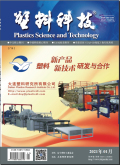塑料科技2024,Vol.52Issue(4):23-27,5.DOI:10.15925/j.cnki.issn1005-3360.2024.04.005
不同注射温度和热处理对聚醚醚酮/碳纤维复合材料摩擦磨损性能的影响
Effects of Different Injection Temperatures and Heat Treatments on Friction and Wear Properties of PEEK/CF Composites
摘要
Abstract
In order to optimize the molding process of polyetheretherketone(PEEK)and improve the wear resistance of the material and expand the range of applications,carbon fiber(CF)is used as reinforcing phase and PEEK/CF composites under different heat treatment processes were prepared at different injection temperature conditions.Tribologic properties of composites are tested by tribo-wear testing machines,and surface analysis and performance tests are performed using a X-ray diffraction,a white light interferometer,and a scanning electron microscope.The results show that the injection temperature and heat treatment process have no effect on the phase of PEEK/CF composites.With the increase of injection temperature,the friction coefficient and wear of the sample surface show a trend of decreasing first and then increasing,while the friction coefficient and wear rate of the sample after tempering are smaller.When the injection temperature is 175℃,the friction coefficient of the tempered material is the lowest,which is 0.091 4,and the wear rate is the lowest,which is 0.106×10-6 mm3/(N·m).The research indicates that appropriate injection temperature and heat treatment can improve the wear reduction and wear resistance of PEEK/CF composites.关键词
聚醚醚酮/碳纤维/摩擦系数/磨损率Key words
Polyetheretherketone/Carbon fiber/Friction coefficient/Minimum wear rate引用本文复制引用
施水娟,卞达,李佳红,王恺璇,徐鹏程,赵鹏,赵永武,陈义..不同注射温度和热处理对聚醚醚酮/碳纤维复合材料摩擦磨损性能的影响[J].塑料科技,2024,52(4):23-27,5.基金项目
国家自然科学基金项目(51675232) (51675232)
江苏省自然科学基金(BK20190611) (BK20190611)

